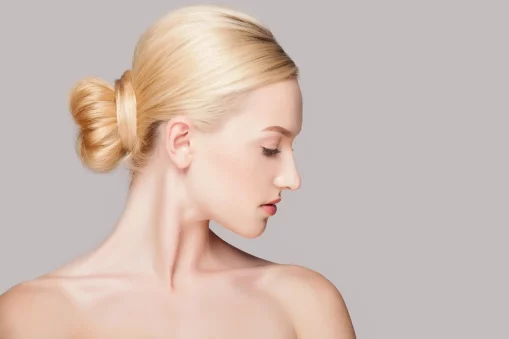The days of relying on a single dermal filler for all treatment areas are long gone. Today, experienced practitioners understand that no one filler can do it all — each formulation has its own strengths. We can carefully combine different fillers, and get a more balanced, natural-looking result.
Some fillers work best for deep structural support, while others provide subtle refinement in delicate areas like the lips or tear troughs. The right combination can enhance longevity, improve integration, and reduce the need for excessive product in any one area. However, this approach requires a deep knowledge of anatomy, product properties, and injection techniques.
Whether it’s combining hyaluronic acid (HA) with collagen stimulators like poly-L-lactic acid (PLLA) or layering different viscosities of HA for a smoother finish, the possibilities for customization are nearly endless. In this guide, we’ll explore how blending dermal fillers can boost treatment results and lead to greater patient satisfaction. Let’s set a new standard for non-surgical facial rejuvenation together.
Different Dermal Filler Types
Each filler type has unique properties, including composition, longevity, biostimulatory effects, and ideal treatment areas.
Hyaluronic Acid (HA) Fillers
Hyaluronic acid (HA) fillers are the most widely used injectable fillers due to their biocompatibility, versatility, and immediate volumizing effects. HA is a naturally occurring polysaccharide in the skin. It has hydrophilic properties, which enable it to attract and retain moisture.
HA fillers are ideal for soft tissue augmentation, including:
- Lip enhancement
- Nasolabial fold correction
- Tear trough rejuvenation
- Cheek contouring
- Fine line smoothing
The most popular HA brands are:
- Juvéderm® (Allergan) – Juvéderm Ultra, Voluma, Volbella
- Restylane® (Galderma) – Restylane Lyft, Kysse, Defyne, Refyne
- Belotero® (Merz) – Belotero Balance, Intense, Soft
These FDA-approved brands offer a range of products with varying viscoelastic properties to suit different treatment goals. But there are also differences, for example, between Restlayne and Juvederm,
Calcium Hydroxylapatite (CaHA) Fillers
Calcium hydroxylapatite (CaHA) fillers are biostimulatory injectables composed of synthetic calcium microspheres suspended in a gel carrier. They provide structural support, deeper volumization, and long-term collagen stimulation.
CaHA fillers are particularly effective for:
- Enhancing jawline and chin definition
- Restoring volume in the midface and cheeks
- Improving deep nasolabial folds and marionette lines
- Hand rejuvenation
One of the most well-known CaHA fillers is Radiesse® (Merz Aesthetics), which is FDA-approved and used for facial contouring and collagen biostimulation.
Poly-L-Lactic Acid (PLLA) Fillers
Poly-L-lactic acid (PLLA) fillers are purely biostimulatory, meaning they do not provide immediate volume but instead stimulate the body’s natural collagen production over several months.
PLLA fillers are popular for:
- Restoring volume in the temples, cheeks, and jawline
- Treating facial lipoatrophy (fat loss due to aging or medical conditions)
- Improving skin laxity in areas like the neck and décolletage
The most prominent PLLA filler is Sculptra® (Galderma), which has been extensively studied for its long-lasting collagen-boosting effects. Find out how it compares to Radiesse.
Polynucleotide-Based Fillers
Polynucleotide-based fillers represent an innovation in aesthetic medicine, utilizing biologically derived DNA fragments to enhance skin regeneration, hydration, and elasticity.
Polynucleotide fillers are ideal for areas where skin texture and elasticity are a concern:
- Under-eye rejuvenation (reducing dark circles and crepey skin)
- Fine lines around the mouth and cheeks
- Neck and décolletage tightening
- Scar improvement and post-laser skin repair
Why Consider Combining Different Fillers?
Let’s talk about essence first.
Many heard that using multiple filler types within a single treatment session is great, but how exactly? Since facial aging affects different tissue layers in distinct ways (ranging from bone resorption and fat loss to skin laxity and fine lines) no single filler formulation can adequately address all concerns. But you can do that if you mix.
For example, hyaluronic acid (HA) fillers are excellent for restoring volume in softer areas. Meanwhile, calcium hydroxylapatite (CaHA) fillers are better suited for deeper structural support because of its greater density and collagen-stimulating effects.
And so he. If you know the needs of the patient and the characteristics of the filler well enough, you can do miracles.
Techniques for Blending Fillers
Practitioners must adjust their approach based on fillers and patient’s factors.
Layering Approach
The layering technique involves injecting different fillers at varying depths to address multiple concerns simultaneously. This approach is particularly useful for treating age-related volume loss and structural deficiencies.
For example, in the midface, a calcium hydroxylapatite (CaHA) filler can be placed in deeper layers to provide foundational support and stimulate collagen production. Once the deeper structural elements are addressed, a hyaluronic acid (HA) filler can be injected more superficially to soften fine lines and improve skin hydration.
A study published in the Journal of Cosmetic Dermatology found that layering CaHA and HA fillers in the midface region resulted in superior volumization and patient satisfaction.
Mixing Fillers
In certain cases, pre-mixing fillers before injection can boost the synergistic effects of their individual components. This technique requires extensive knowledge of filler compatibility and rheology, as not all fillers can be safely or effectively combined in a single syringe.
One emerging approach involves blending a highly cohesive HA filler with a CaHA filler, creating a hybrid formulation that delivers both immediate volume and long-term collagen stimulation. According to a clinical study published in Dermatologic Surgery, this method resulted in improved structural support and lifting effects in the cheeks and jawline, with sustained results lasting over 12 months.
Keep in mind that inappropriate combinations can lead to uneven distribution, unpredictable resorption rates, or even complications such as nodules.
Regional Application
Rather than using the same filler across the entire face, a region-specific filler selection is based on the unique needs of each facial zone.
For example:
- Temples & Midface: Poly-L-lactic acid (PLLA) fillers are ideal for temples, where gradual collagen stimulation is beneficial.
- Jawline & Chin: CaHA fillers provide the necessary structural support to enhance jawline definition and reduce jowling.
- Lips & Tear Troughs: HA fillers with a softer, more fluid consistency are preferred for delicate areas.
- Neck & Décolletage: Polynucleotide-based fillers are emerging as a promising option for improving skin quality, elasticity, and hydration in these sensitive regions.
Safety Considerations
Before proceeding with any combination filler treatment, a detailed patient evaluation is crucial. This includes:
- Medical History: Identifying any contraindications such as autoimmune disorders, bleeding disorders, allergies to filler components, or a history of keloid formation.
- Previous Aesthetic Treatments: Understanding past filler injections, including the type of product used, injection sites, and patient response.
- Skin Quality and Facial Anatomy: Assessing skin elasticity, volume loss, and underlying structural deficiencies.
- Aesthetic Goals and Expectations: Clear communication about expected results, longevity, and potential touch-up sessions.
Providing patients with comprehensive information about the procedure, including benefits, potential risks, and alternative options, is essential. Informed consent should include:
- A detailed explanation of the chosen fillers, their purpose, and how they interact.
- Possible adverse effects, such as swelling, bruising, filler migration, or delayed-onset nodules.
- A discussion on longevity and the need for maintenance treatments.
- Emergency protocols for rare but serious complications, such as vascular occlusion or an allergic reaction.
Key safety measures include:
- Aseptic Technique: Using sterile gloves, disinfecting the skin thoroughly, and ensuring all instruments are sanitized to minimize infection risk.
- Cannula vs. Needle Selection: In areas with high vascularity, such as the tear troughs or nasolabial folds, a blunt-tip cannula may reduce the risk of vascular occlusion compared to sharp needles.
- Aspiration Before Injection: Practitioners should always aspirate before injecting to confirm they are not in a blood vessel.
- Gradual Injection and Low Pressure: Depositing filler slowly allows tissues to accommodate the product and minimizes complications.
- Avoiding Overfilling: Overcorrection can lead to lumpiness, asymmetry, or an unnatural appearance
Final Thoughts
Once you master blending dermal fillers you will see how many options you will have available to offer your patients. You can restore lost volume, refine contours, improve skin quality, and even stimulate collagen production by layering different formulations.
Yet, don’t forget that successful filler blending requires an in-depth understanding of facial anatomy, aging patterns, and the way different filler types interact within the skin.
As patient expectations continue to evolve, so does the need for innovative, multi-dimensional treatment plans. This is one of them.
Frequently Asked Questions (FAQs)
What are the most common mistakes when blending different types of fillers?
The most common mistakes include improper layering, using incompatible fillers, and failing to account for varying degradation rates. Injecting fillers with different densities too close together can lead to uneven results or migration. Overcorrecting with multiple fillers at once can also create unnatural volume or texture inconsistencies.
How does a patient’s skin type affect the choice of filler combinations?
Skin type influences how fillers integrate and the risk of side effects. Thinner skin requires softer, more fluid fillers to prevent visibility or irregularities, while thicker, more resilient skin can handle denser fillers for structural support. Ethnic skin types may have a higher risk of post-inflammatory hyperpigmentation (PIH).
Are there specific filler combinations recommended for mature skin?
Yes, mature skin benefits from a combination of volumizing and collagen-stimulating fillers. HA fillers restore hydration and immediate volume, while CaHA or PLLA fillers provide longer-term structural support by stimulating collagen production.
How does the immune system respond to multiple filler types injected in the same session?
The immune response varies depending on the filler type and patient sensitivity. HA fillers have a low immunogenic profile, while biostimulatory fillers like PLLA and PMMA can trigger a stronger immune response. Pre-existing inflammation or previous filler reactions should be considered before combining multiple products, as well as repeated procedures.
Are there regulatory restrictions on combining different brands or types of dermal fillers?
Regulations vary by country, but many health authorities caution against mixing different brands due to potential incompatibilities. Some manufacturers explicitly state that their products should not be combined with other formulations. You should always adhere to local guidelines and product-specific recommendations.
References
Barańska-Rybak W, Antoszewska M. Combination of hyaluronic acid fillers and personalized skincare as a perfect tool in aesthetic medicine. Dermatol Ther. 2021 Sep;34(5):e15092. doi: 10.1111/dth.15092. Epub 2021 Aug 16. PMID: 34369044.
Vachiramon V, Rutnin S, Patcharapojanart C, Chittasirinuvat N. The effect of combined of hyaluronic acid dermal filler and microfocused ultrasound treatment: A clinicopathological study. J Cosmet Dermatol. 2023 Mar;22(3):792-797. doi: 10.1111/jocd.15498. Epub 2022 Nov 14. PMID: 36374232.
Hedén P, Hexsel D, Cartier H, Bergentz P, Delmar H, Camozzato F, Siega C, Skoglund C, Edwartz C, Norberg M, Kestemont P. Effective and Safe Repeated Full-Face Treatments With AbobotulinumtoxinA, Hyaluronic Acid Filler, and Skin Boosting Hyaluronic Acid. J Drugs Dermatol. 2019 Jul 1;18(7):682-689. PMID: 31334927.



0 Comments